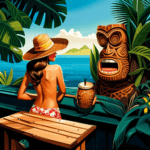The Fascinating World of Tiki Drinks, Tiki History, and Tiki Culture
When it comes to tropical cocktails, one cannot ignore the allure of tiki drinks. These exotic concoctions, often served in colorful ceramic mugs adorned with carved tikis, have become synonymous with a laid-back island vibe and a sense of escapism. But tiki drinks are more than just delicious beverages – they are a reflection of a rich history and a vibrant culture.
The Origins of Tiki Drinks
The origins of tiki drinks can be traced back to the 1930s when a man named Ernest Raymond Beaumont Gantt, better known as Donn Beach, opened a bar called Don the Beachcomber in Hollywood. Inspired by his travels in the Caribbean and South Pacific, Donn Beach created a menu of tropical cocktails that combined rum, fruit juices, and exotic spices. These drinks, served in elaborate vessels and garnished with tropical fruits and umbrellas, quickly gained popularity.
Soon after, another tiki pioneer emerged on the scene. Victor J. Bergeron, also known as Trader Vic, opened his own tiki bar in Oakland, California. Trader Vic’s became famous for its signature drink, the Mai Tai, which blended rum, lime juice, orgeat syrup, and orange liqueur. The Mai Tai became an instant classic and remains one of the most iconic tiki drinks to this day.
The Rise and Fall of Tiki Culture
In the 1940s and 1950s, tiki culture reached its peak. Americans, longing for an escape from the post-war realities, embraced the fantasy of a tropical paradise. Tiki bars and restaurants popped up all over the country, featuring bamboo décor, thatched roofs, and Polynesian-inspired music. Tiki culture became a full-blown phenomenon, with celebrities and regular folks alike flocking to these establishments to indulge in the exotic ambiance and delicious tiki drinks.
However, as the 1960s brought about social and cultural changes, the popularity of tiki culture began to wane. The counterculture movement and a shift towards more natural and organic lifestyles led to a decline in the popularity of overly kitschy and artificial experiences. Tiki bars closed down, and the once-thriving tiki culture seemed to fade away.
The Revival of Tiki Culture
Fortunately, tiki culture experienced a resurgence in the late 1990s and early 2000s. A new generation of bartenders and enthusiasts rediscovered the art of crafting tiki drinks and embraced the retro charm of tiki culture. Tiki bars started to reappear in major cities, and the demand for tiki-inspired cocktails grew once again.
Today, tiki culture is thriving, with tiki bars and tiki-themed events gaining popularity worldwide. Bartenders continue to push the boundaries of tiki drinks, experimenting with new flavors and techniques while paying homage to the classics. Tiki enthusiasts collect vintage tiki mugs and memorabilia, celebrating the nostalgia and escapism that tiki culture represents.
Conclusion
Tiki drinks, tiki history, and tiki culture are an integral part of the cocktail world. From their humble beginnings in the 1930s to their resurgence in recent years, tiki drinks have captured the imagination of people seeking a taste of the tropics. So next time you sip on a fruity, rum-filled tiki drink, take a moment to appreciate the history and culture that goes into each glass.

